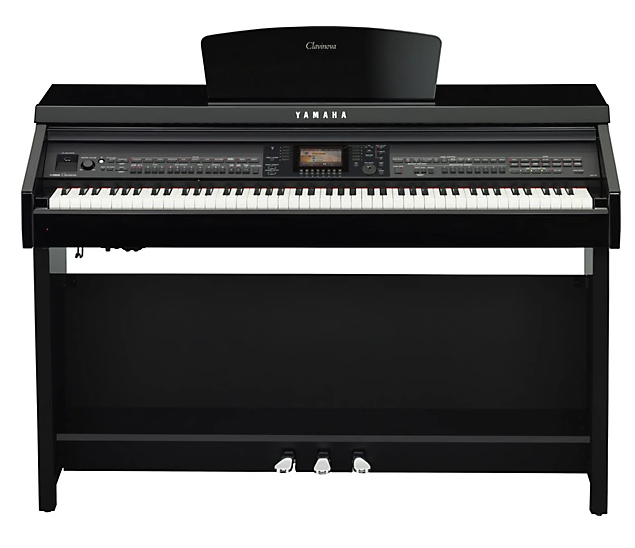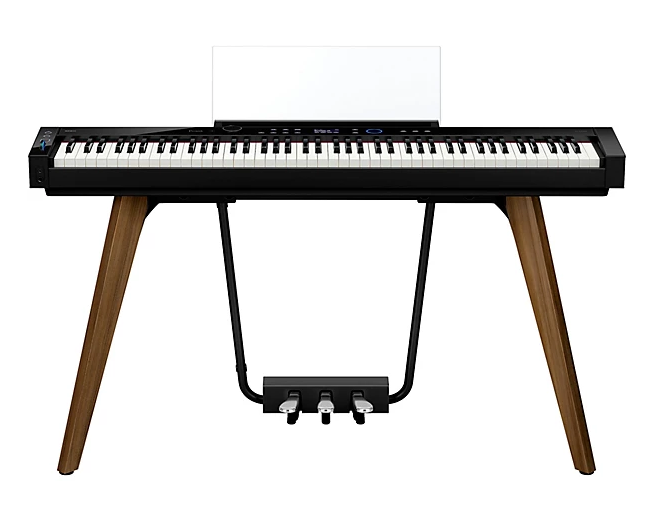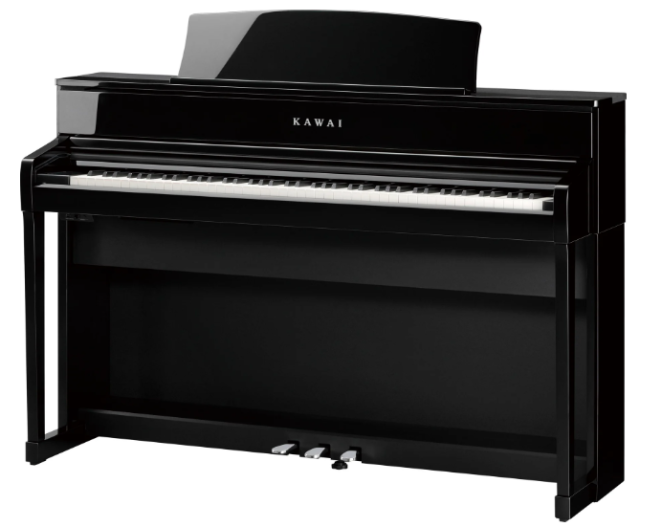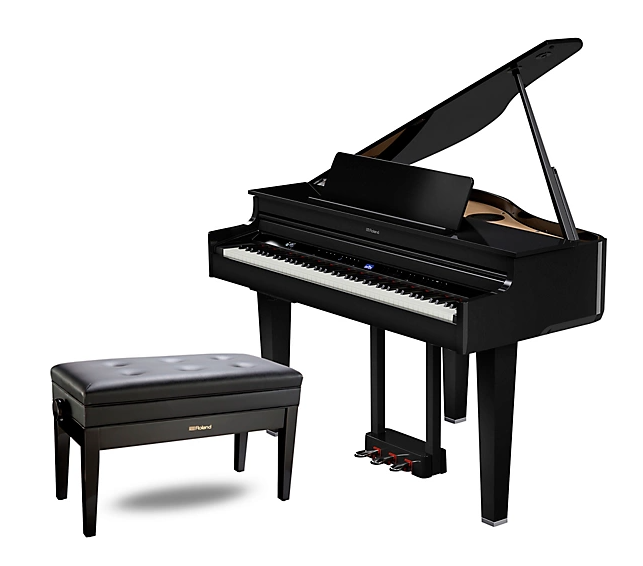Are you looking to upgrade your run-of-the-mill keyboard with a premium piano that plays and feels just like the real thing?
Then a digital piano is undoubtedly the way to go, as it will allow you to enjoy all the expressiveness of an acoustic piano — but with all the perks of a digital instrument.
In this article, I've compiled seven of the very best digital pianos on the market, both for people on a budget and for pros who don't mind spending thousands of dollars. I also threw in a quick buyer's guide to help you find the perfect digital piano for you!
My #1 pick is the Yamaha CK88 — an extremely versatile piano that's right in between stage pianos and at-home models. It's also very affordable, making it a fantastic choice for beginners and more experienced players alike.
The best digital pianos will completely change the way you think about your instrument, so let's find the right one for you!
Quick Summary of the Best Digital Pianos
- Yamaha CK88 (Best Overall)
- Roland FP-30X (Best for Tight Budgets)
- Nord Stage 4 (Best Stage Piano)
- Yamaha Clavinova CVP-701 (Best Upright Piano)
- Casio PX-S7000 (Best for Home Practice)
- Kawai CA701 (Best Concert Piano)
- Roland GP-6 (Best Grand Piano)
Best Digital Pianos
Best Overall
SPECS:
- Keys: 88 GHS keys
- Polyphony: 128 notes
- Voice presets: 363 instruments
The Yamaha CK88 is as close as you can get to a magic one-size-fits-all piano for pretty much everyone. Yamaha has blended together sound quality, incredible feel, and versatility into a single model — and the best part? It somehow manages to stay below the 1500-USD barrier!
The CK88 comes from merging together the very best of Yamaha pianos with the latest stage keyboard technology. Featuring a graded hammer keybed, the CK88 feels like an acoustic piano, but with all the added perks of a modern synth-like keyboard.
The on-board controls include effects such as reverb, delay, and modulation as well as filters, envelope controls, and drawbars (for organ sounds). Combine this with sound layering and splitting, and you've got a whole new sonic playground in your hands!
All in all, the Yamaha CK88 is an incredibly solid choice for any musician, allowing you to get the best of Yamaha keyboards at an affordable price. You just can't go wrong with this one — even if you're more of a classical music player yourself!
What Could Be Improved
- A bit expensive for beginners
Best for Tight Budgets
The Roland FP-30X is the perfect choice for anyone looking to save a few bucks while still getting a realistic sound and feel.
SPECS:
- Keys: 88 PHA-4 keys
- Polyphony: 256 notes
- Voice presets: 56 instruments
The Roland FP-30X has earned quite a reputation for itself among both beginner players and experienced musicians on a budget. But don't judge a book by its cover — the FP-30X is an incredibly versatile piano that can rival even the most expensive models on the market.
Maybe the most important aspect of the Roland FP-30X is its top-of-the-line keybed, which features 88 "Ivory Feel" keys with progressive hammer action. This allows for a mind-blowingly realistic feel that's nothing short of most acoustic pianos.
The FP-30X is also equipped with Roland's flagship SuperNATURAL sound engine. This allows you to capture every nuance in your playing, mimicking all the subtle details of an acoustic instrument. Combine this with 56 different sound presets, and you've got a true monster in your hands!
Of course, there are some downsides to getting a budget piano — most noticeably, the action may seem a bit too heavy for professional players. But the Roland FP-30X is honestly as good as it gets in this price range, and even more so if you're just starting out playing piano.
What Could Be Improved
- Not the most realistic keybed
Best Stage Piano
The Nord Stage 4 is a high-end digital piano that's perfect for experienced musicians looking to upgrade their on-stage playing.
SPECS:
- Keys: 88 hammer-action keys
- Polyphony: 120 notes
- Voice presets: 512 programs
Now we're getting to the expensive stuff — but as any experienced musician knows, the more money you spend, the more authentic playing experience you're getting (usually). And believe me: it's hard to beat the Nord Stage 4 even at its price range.
The Nord Stage 4 offers a full synth-like experience with three different sound engines for piano, organ, and synthesized sounds. Each sound can be layered with up to two other sounds, and the independent FX controls allow for a versatility that's pretty much unheard of.
The keybed doesn't fall behind either — the Nord Stage 4 is equipped with 88 fully weighted keys with triple sensors to capture all the details in your playing. Throw in an accurate polyphonic aftertouch, and you've got yourself a true powerhouse at your disposal.
Of course, all this complexity and versatility doesn't come without its cost: the Nord Stage 4 is almost 6000 dollars. But if you're an experienced player looking to really up your game, then this hefty price tag is absolutely worth it. Remember — you can't go wrong with a Nord.
What Could Be Improved
- Very expensive
Best Upright Piano
The Yamaha Clavinova CVP-701 fuses together an ultra-realistic playing experience with the versatility of more beginner-friendly keyboards.
SPECS:
- Keys: 88 GH3X keys
- Polyphony: 256 notes
- Voice presets: 777 instruments
The Yamaha Clavinova series is a set of world-renowned digital pianos that aim to recreate the grand piano experience with all the versatility of a digital keyboard. The Clavinova CVP-701 is among the best of the whole line — and for a good reason.
The Yamaha Clavinova CVP-701 features an ultra-realistic graded hammer 3X keybed with escapement, equipped with synthetic ivory keytops. Pair this with piano sounds taken from the top-notch Bosendorfer Imperial and the Yamaha CFX, and the CVP-701 is as close as it gets to the real thing.
But the Clavinova CVP-701 doesn't just cater to advanced players looking for a realistic experience! This incredible digital piano also features 40 different accompaniment styles as well as over 700 voice presets.
Of course, the price tag reflects all of this — but the Clavinova CVP-701 is absolutely worth it if you're willing to break the bank.
What Could Be Improved
- Not portable
Best for Home Practice
The Casio PX-S7000 is a top contender for players of any skill level looking for a mid- to high-end at-home digital piano.
SPECS:
- Keys: 88 Smart Hybrid hammer-action keys
- Polyphony: 256 notes
- Voice presets: 400 instruments
Now, we've looked at two high-end pianos that easily surpass the 4000-dollar barrier — so it's the perfect time to tone down for a bit with the Casio PX-S7000. Sleek, modern, and straightforward, this Swiss Army knife of a piano is, by far, one of the best home digital pianos on the market.
The Casio PX-S7000 aims to deliver a simplistic yet deeply expressive playing experience without taking up too much space in your room. And the best part? Equipped with 88 smart hybrid hammer action keys, the PX-S7000 doesn't sacrifice any realism for it.
The PX-S7000 also features string and damper resonance simulation, 400 voice presets, 256-note polyphony, and on-board effects. Plus, the included metronome and 3-pedal unit are much appreciated for practicing, as well as the pitch bend wheel for that extra synth touch.
What Could Be Improved
- Not as affordable as other options
Best Concert Piano
The Kawai CA701 is as close as you can get to a real concert piano, both in terms of feel and sound.
SPECS:
- Keys: 88 wooden, grade-weighted keys
- Polyphony: 256 notes
- Voice presets: 106 instruments
If I could define the Kawai CA701 in two words, they would definitely be thrillingly realistic. This true powerhouse of a keyboard looks as elegant as it sounds, and the top-of-the-line feel and response are nothing short of those of a world-class concert piano.
The CA701 features Kawai's trademark, ground-breaking "Grand Feel III" wooden-key keybed which is, of course, fully weighted. But the true magic happens inside the sound engine — the "Grand SK-EX Rendering" engine fuses together several realistic sounds for a smooth transition between all octaves.
But the realism doesn't stop there: the Kawai CA701 also features Kawai's Grand Feel Pedal System, which perfectly emulates the weight and response of real acoustic pianos. And, of course, the cabinet doesn't fall behind, offering a sleek design with a smooth sliding key cover for those days when you're just tired of playing.
If you're a classical musician or a professional pianist looking to really upgrade your stage presence, then this is the way.
What Could Be Improved
- As expensive as it is realistic!
Best Grand Piano
SPECS:
- Keys: 88 Reality Hybrid Premium keys
- Polyphony: 256 notes
- Voice presets: 324 instruments
The Roland GP-6 is the best of the very best when it comes to digital pianos. Unlike most other options on the market, this absolute monster imitates grand pianos not only in terms of sound, but literally in every single other aspect.
The Roland GP-6 features 88 Reality Hybrid Premium keys, which offer the playability and expressiveness of a true acoustic piano. Even while playing the most demanding of staccatos or the subtlest of pianissimos, the GP-6 will capture every single detail in your playing.
Of course, Roland included 324 onboard sounds for you to enjoy when you want to... step away from your classical repertoire. But by far the most enjoyable and ground-breaking feature of the Roland GP-6 is that the speakers are beneath the lid, allowing you to open it when you want a fully uncompromised sound.
If there was ever anything like a best digital piano keyboard, then it definitely is the Roland GP-6. But be warned: it can get expensive.
What Could Be Improved
- Prohibitively priced for some
Digital Pianos Buyer's Guide
Anyone who has a little bit of experience in the music industry will agree that buying a new instrument can be as daunting as it is exciting. And this is even more true when it comes to digital pianos!
There are dozens of factors to keep in mind, all while trying to stay within your desired budget and catering to your personal preferences. But fret not — I compiled a short (but comprehensive) buyer's guide to get you started out:
Key Action and Weight
A digital piano, of course, tries to imitate an acoustic piano — so there's nothing more important than an expressive, realistic, and durable keybed.
And it all starts with key action! The action of an acoustic piano refers to how the keys feel, as each of them is connected to a hammer that hits the string corresponding to that note. Naturally, this hammer has its own weight, making the keys feel heavy and responsive.
Hammer action keyboards, including most pianos on this list, emulate this feeling by adding "artificial" hammers to each key. While these aren't necessarily connected to any sound-producing triggers, they provide that much-needed realistic feel and expressiveness.
Some high-end pianos, such as the Yamaha Clavinova CVP-701, take this a step further by adding more complex features such as escapement emulation and extra key press sensors. Of course, these aren't necessary if you aren't after the most realistic piano out there — but they are definitely nice to have!
Number of Octaves
Digital pianos usually try to imitate an acoustic piano as closely as possible, so most models will provide 88 keys comprising almost eight octaves. But some digital pianos also offer some smaller options, often featuring 61 (or even fewer) keys!
For most pianists, however, 88-key pianos are undoubtedly the way to go. Getting fewer keys can quickly lead to limitations down the road — especially if you're dealing with complex classical pieces.
61-key or more compact models may be useful for beginners who may not have a lot of space in their room or for gigging musicians who carry their instruments around a lot. But my personal recommendation is getting 88 keys unless you really need that extra portability.
Instrument Voices
Now we get to the fun stuff!
Most digital pianos offer more than just your classic, top-of-the-line piano sound, usually including alternative voices or tones such as electric pianos, organs, and strings. Some models are more focused on providing just a few high-quality presets, while others, such as the Casio PX-S7000, offer hundreds of great sounds.
If you're a classical musician, you may not find a lot of use for these besides some off days when you're just looking to have some fun playing. But if you're more of a jamming pianist, then having several preset options can definitely pay off in the long run!
My personal recommendation for pretty much everyone is to get a digital piano that offers at least these few basic voice options:
- Grand piano (duh)
- Electric pianos (such as a Rhodes or Wurlitzer emulation)
- Organ
- Clavichord
- Vibraphone
- Strings
Of course, some pianos like the Nord Stage 4 offer a more synth-like approach, allowing you to tweak the sounds or even create them from scratch. Just how much control you need over your sound is entirely up to you!
Overall Connectivity
Connectivity, or overall I/O, is an often overlooked aspect of digital pianos. To put it bluntly, this refers to the different ins and outs of the keyboard, including MIDI, USB, jacks, and even mobile apps!
Most digital pianos will feature stereo line jacks for you to connect your instrument either to an amp or to an audio interface (in case you want to record). Similarly, they will also have one or two headphone jacks for times when you want to skip the onboard speakers.
MIDI connectivity is often included as well — although the specifics will vary depending on each model. Some pianos handle MIDI through a simple USB port, which will mostly be useful if you're connecting your piano to a computer. Other digital pianos, instead, offer a full-on set of MIDI IN, OUT, and even THROUGH jacks! Check out the best MIDI keyboards here.
Last but not least, some pianos will also come with extra software for you to connect either wirelessly or through a USB cable. These can be very useful for beginners, as they often offer perks such as piano lessons or free sheet music to help you start your journey.
Pedals
Finally, you absolutely have to consider pedal capabilities when you're shopping for a digital piano. The budget models will usually only support a sustain pedal (also called a damper pedal). This is absolutely essential for most playing styles, so make sure you don't skip out on this!
But if you're a more advanced pianist, you'll also want to look into a sostenuto pedal, which is similar to the previous pedal but with the difference that it only affects certain keys. While this one isn't as necessary as a damper, it's still much appreciated.
The third pedal is, of course, the soft pedal (also known as una corda pedal), which softens up the overall piano sound. This is arguably the least necessary of the three — but it can be a great addition if you're a classical musician.
The more advanced digital pianos will usually allow you to either connect a single sustain pedal or a three-pedal unit containing all of the above-mentioned pedals.
Best Digital Pianos Frequently Asked Questions (FAQ)
What are the best beginner digital pianos?
I would personally recommend starting out with something like the Roland FP-30X or the Yamaha CK88. Both of these are fantastic pianos that will offer you everything from realistic hammer action to plenty of tone presets without breaking the bank.
If budget is not a concern, then you could also opt for the Casio PX-S7000, which provides a few extra perks that will definitely be worth it in the long run. Buying a more high end digital piano while you're a beginner is probably overkill!
What's the difference between a keyboard and a digital piano?
Honestly? There isn't a strict definition for these two terms. But generally speaking, digital or electric pianos will try to emulate a real piano as closely as possible, while a keyboard isn't necessarily tied to resembling a true piano.
As such, digital pianos will usually provide, at the very least, hammer action, 88 keys, and that classic piano look. Keyboards, on the other hand, may feel and look more like a synth or a MIDI keyboard instead of a piano.
What's the best digital piano brand?
Well, it's hard to determine which brand is king when it comes to the digital piano market. Roland, Nord, and Yamaha, however, are three fantastic contenders — although Casio and Kawai don't fall too far behind either.
If I had to pick only one, I'd probably go with Yamaha, as they are just too reliable to skip out on. Yamaha keyboards have been around for ages, and the team behind these fantastic instruments is always looking out for the latest developments in digital piano technology.
Are there any downsides to getting a budget piano?
Not necessarily! Sadly, the music world is plagued with the belief that spending more money automatically means a better experience. But several of the latest digital piano models have proved this notion wrong time and time again.
Pianos such as the Yamaha CK88 or the Roland FP-30X are very affordable models that are perfectly suitable for players of all levels. Of course, they aren't the most realistic in the market — but you just can't go wrong with them if you take into account the price tag.
If you're looking for more lower-priced digital pianos, check out our guides to the best digital pianos under $1000 and the best digital pianos under $500.
Verdict
Finding the ideal digital piano for you can be a daunting challenge, to say the least. There are several factors to keep in mind, the most important one being, of course, key action and weight.
This will determine just how realistic the keybed feels and plays, which is crucial in determining the overall expressiveness of the instrument. Similarly, you should also keep in mind aspects such as instrument voices, pedals, and connectivity capabilities.
If you're looking for an affordable, yet versatile and premium digital piano, then definitely look into my top pick: the Yamaha CK88. But if you're looking at options a bit below this price range, check out the Roland FP-30X instead!







